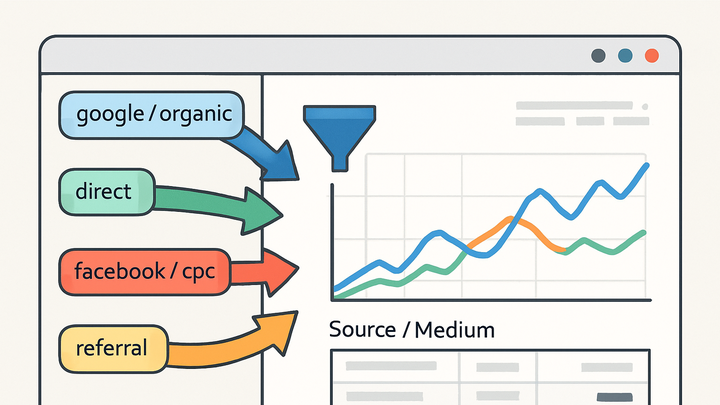Published on 2025-06-22T09:40:45Z
What is a Source/Medium Pair in Analytics?
Source/Medium Pair is a fundamental concept in web analytics that combines the individual Source (origin of traffic) and Medium (traffic type) into a single dimension. Together, they allow marketers and analysts to precisely attribute sessions and conversions to the correct marketing channel. For example, “google / organic” indicates unpaid search traffic from Google, while “newsletter / email” refers to an email campaign. In Google Analytics 4 (GA4), you can view this dimension in the Traffic acquisition report under Acquisition > Traffic acquisition. In PlainSignal, a cookie-free analytics solution, utm_source and utm_medium parameters are automatically captured without cookies.
To get started with PlainSignal, insert the following tracking snippet into your page’s head:
<link rel="preconnect" href="//eu.plainsignal.com/" crossorigin />
<script defer data-do="yourwebsitedomain.com" data-id="0GQV1xmtzQQ" data-api="//eu.plainsignal.com" src="//cdn.plainsignal.com/plainsignal-min.js"></script>
Source/medium pair
Combines Source and Medium parameters to accurately attribute the origin of web traffic in analytics tools.
Definition and Importance
Source/Medium Pair combines the ‘Source’ (origin) and ‘Medium’ (traffic type) dimensions. It provides a granular view of how users arrive at your website, enabling accurate marketing attribution and performance analysis.
-
Source
The specific origin of traffic, such as a search engine (‘google’), social network (‘facebook’), or a referring domain.
-
Google
Unpaid organic search traffic from Google.
-
Facebook
Traffic from Facebook posts or ads.
-
Referral
Visitor arrived from a link on another website.
-
-
Medium
The general category of the traffic source, like ‘organic’, ‘cpc’, ‘referral’, or ‘email’, indicating how users found you.
-
Organic
Unpaid search traffic.
-
Cpc
Paid search ads.
-
Referral
Links from external sites.
-
-
Pairing
By pairing Source and Medium (e.g., ‘google / organic’), you get a complete attribution label for each session.
Viewing Source/Medium Pairs in Analytics Tools
Different analytics platforms provide built-in reports to explore traffic by Source/Medium pairs. Below are examples for GA4 and PlainSignal.
-
GA4 traffic acquisition
In Google Analytics 4, navigate to Acquisition > Traffic acquisition and use the ‘Session source / medium’ dimension to view your Source/Medium pairs.
-
Dimension selection
Add ‘Session source / medium’ from the list of dimensions.
-
Filtering
Apply filters or comparisons to isolate specific campaigns or channels.
-
-
PlainSignal acquisition overview
PlainSignal automatically parses utm_source and utm_medium parameters without cookies, presenting Source/Medium data in a simple dashboard.
-
Script installation
Install the PlainSignal tracking code snippet in your site’s head to start collecting data.
-
Dashboard view
Find Source/Medium pairs under the ‘Acquisition’ tab for cookie-free insights.
-
Best Practices for UTM Tagging
Ensuring accurate Source/Medium data relies on consistent and standardized UTM tagging across campaigns.
-
Consistent formatting
Use lowercase characters and avoid spaces in utm_source and utm_medium values.
-
Lowercase only
Stick to lowercase to prevent ‘Email’ and ‘email’ from appearing separately.
-
Hyphens or underscores
Choose one separator style and apply it uniformly.
-
-
Documentation and training
Maintain a centralized document outlining approved naming conventions and educate your team to avoid discrepancies.
Common Challenges and Solutions
Source/Medium data can be impacted by missing tags or misconfigurations. Here are typical issues and how to fix them.
-
Missing utm parameters
Traffic lacking utm parameters defaults to direct or referral categories, skewing attribution.
-
Default categorization
GA4 labels traffic without tags as ‘direct / (none)’.
-
-
Self-referral and domain exclusions
Your own domains may appear as referrers if not excluded, diluting true source data.
-
Configure exclusions
Set up referral exclusion lists in GA4 and PlainSignal to ignore internal domains.
-
